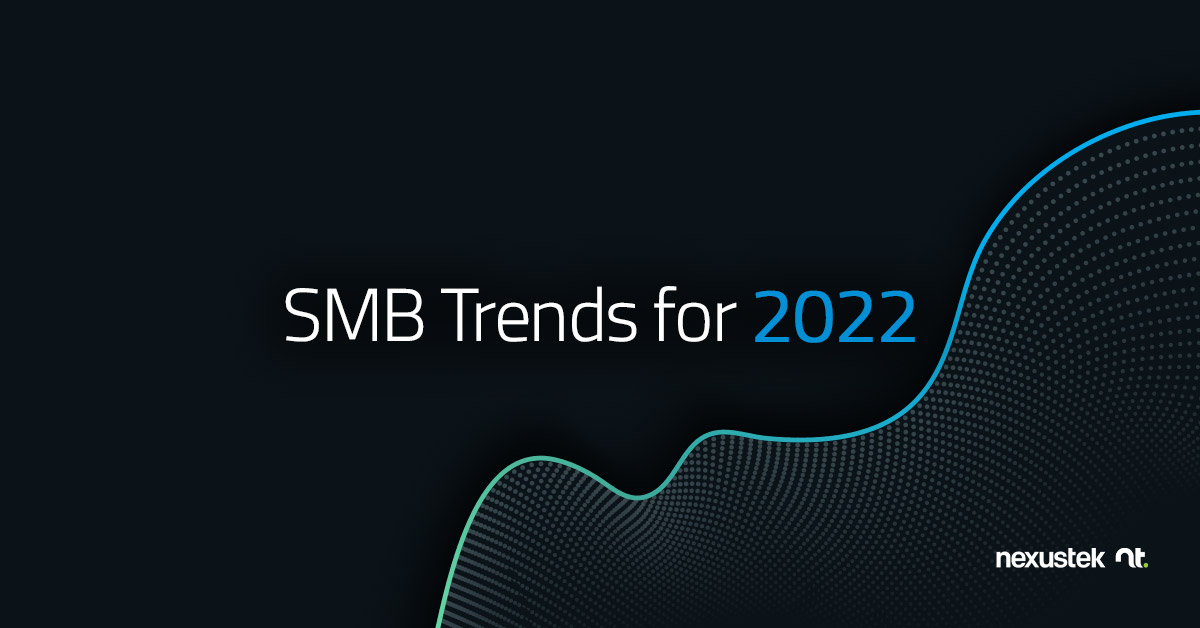READ TIME: 4 MIN

SMB Trends for 2022
The new year has arrived! For businesses, it is a time to celebrate the successes of 2021, reflect on the lessons learned, and strategize how to enhance the business going forward.
The workforce has changed rapidly over the last 24 months. Although the technology term “digital transformation” has been a buzzword for a few years now, a multi-year global pandemic and evolving employee workforce preferences has accelerated the adoption of this tech philosophy.
We’ve compiled what the market experts are saying some of the technology and employee trends will be for small to mid-sized businesses (SMBs) in 2022.
“Big Business” Systems and Processes
Customers have easy access to information at the tip of their fingers, and they’re doing more research about the products and services they’re interested in before initiating contact with a company. According to Keenfolks, 87% of buyers now begin product searches online, 75% of consumers expect a consistent experience across every channel, and 67% of customers prefer self-service over speaking to a company representative.
What do all those stats mean for SMBs?
It means if your business processes and technology are not making it easy for customers to self-research your company, engage with your brand across different channels, or provide a certain level of self-service automation (for both prospective and current customers), you may be missing a golden opportunity to stand out from your competitors.
Deliver the “seamless and easy” experience consumers have come to expect in the marketplace by utilizing cloud-enabled technologies and automated process where it makes sense for your business model.
Hybrid & Remote Workforces
Initially thought to be a temporary solution to navigate around the recent pandemic, companies are now faced with an inevitable truth…employees do not want (and are refusing) to go back to the office.
Over the last year and a half, the “experiment” of remote working has shown that businesses can still operate smoothly, employees are productive (some research shows an increase in production versus in an office) and they prefer the flexibility that comes with remote working.
Consider these stats from Forbes Magazine:
- 97% of employees do not want to return to the office full-time
- 61% of employees prefer to be fully remote
Of course, not every business can be fully remote, as some jobs require in-office/field workers to perform essential tasks to meet the demands of the business. Sometimes a hybrid of remote/in-office policies and procedures work better for some businesses.
Whichever option better fits your business needs, make sure your business-critical applications and data are accessible in a secure cloud environment, your employees have cloud-based productivity and collaboration software (e.g., Microsoft Office 365 and Teams), and your networks have end-point security protection to defend against increasing cyberattacks on remote workforces.
Strategic Inventory Management
Over the last several months, businesses across the U.S. have been faced with supply chain challenges brought on by the lingering pandemic effects of economies shutting down, manufacturing slow down (or coming to a complete halt), and the limited availability of raw materials.
This trend will continue well into 2022, so businesses of all sizes and in all industries must be prepared to manage their inventory accordingly and manage customer expectations.
Technology like cloud-enabled ERP systems and the ability to provide mobile real-time data updates will help with tracking and forecasting product inventory, as well as the accompanying labor/services your business delivers.
In a recent Forbes article, Rick Itzkowich states, “Supply chain shortages are not going away. Delays in getting raw materials and delivering finished products are going to be longer than expected. Planning, adjusting, and strategizing your inventory management is critical. Manufacturers look to increase raw materials, as the cost of not having a product is higher. If your company isn’t suffering directly, your customers are feeling the stress.”
Employee Experience and Career Development
Your people are your most valuable asset. The ability to work remote, and the work/life balance it provides, has become the standard in the minds of many workers. Couple that with the now expanded job market, where talent can be accessed from across the U.S. instead of confined within your city, employees want more from their employers.
Chris Herd, Founder and CEO at Firstbase, captured this when he stated, “Companies who adopted technology 20 years ago replaced every company that didn’t. Companies who adopt remote work will replace every company who doesn’t in 20 years. The reason is incredibly simple: Talent and efficiency.”
People are now empowered more than ever to ask the question “why should I work for your company?”.
In addition to flexibility with remote working, make it a point to build and/or reinforce a company culture that lets your employees know they’re valued and can grow. Create an employee experience, from new hire on boarding to career development, that demonstrates to employees that you’re invested in helping them succeed in their role. Train your employees with new skills and look for opportunities to promote from within.
Businesses that offer growth opportunities and create an employee-focused culture are more likely to attract top talent, reduce employee turnover and increase performance.






